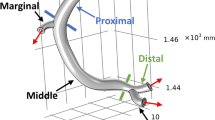Abstract
A quasi-one-dimensional non-linear mathematical model for the computation of the blood flow in the human systemic circulation is constructed. The morphology and physical modelling of the whole system (arteries, capillaries and veins) are completed by different methods for the different vessel generations. A hybrid method is used to solve the problem numerically, based on the governing equation (continuity, momentum and state equations), the input boundary conditions and the predetermined initial conditions. The two-step Lax-Wendroff finite-difference method is used to compute variables for each individual vessel, and the characteristic method is employed for the computation of internal boundary conditions of the vessel connection and the input and output system boundary conditions. Using this approach, blood flow, transmural pressure and blood velocity are computed at all vessel sites and for each time step. The pressure and flow waveforms obtained show reasonable agreement with clinical data and results reported in the literature. When an external conservative force field is applied to the system, the results computed from the model are intuitively correct. The term representing the external pressure added to the system by the muscle, which represents active control on the cardiovascular system, is also embodied in this model.
Similar content being viewed by others
References
Avolio, A. P. (1980): ‘Multi-branched model of the human arterial system’,Med. Biol. Eng. Comput.,18, pp. 709–718
Bai, J.,et al., (1987): ‘The use of a mathematical model to study method of anti-G protection.’ Proc. Ninth Annual Conf. of the IEEE Engineering in Medicine & Biology Society, pp. 1129–1130
Bergel, D. H. (1972): ‘Cardiovascular fluid dynamics’ (Academic Press Inc.)
Brower, R. W.,et al., (1969): ‘Difficulties in the further development of venous hemodynamics’,IEEE Trans.,BME-16, (4), pp. 335–338
Collins, R., andMaccario, J. A. (1979): ‘Blood flow in the lung,’J. Biomech.,12, pp. 373–395
Eder, O. J., andSuda, M. (1988): ‘Network simulation of an arterial system using a hydrodynamic model.’ Proc. BME-Austria 88, Graz, Austria, June, pp. 9–11
Guyton, A. C. (1987): ‘Human physiology and mechanisms of disease (W.B. Saunders)
Jaron, D.,et al., (1984): ‘A cardiovascular model for studying impairment of cerebral function during +Gz stress,’Aviat., Space & Environmental Med., pp. 24–30
Kivity, Y., andCollins, R. (1974): ‘Nonlinear wave propagation in viscoelastic tubes: application to aortic rupture’,J. Biomech.,7, pp. 67–76
Latham, R. D., Westerhof, N., Sipkema, P., Rubal, B. J., Reuderink, P., andMurgo, J. P. (1985): ‘Regional wave travel and reflections along the human aorta: a study with six simultaneous micromanometric pressures’,Circ.,72, (6), pp. 1257–1269
Milnor, W. R. (1982): ‘Hemodynamics’ (William & Wikins, Baltimore)
Noordergraaf, A.,et al., (1963): ‘The use of an analog computer in a circulation model’,Prog. Cardiovasc. Disease,5, pp. 419–439
Richtmyer, R. D., andMorton, K. W. (1967): ‘Difference methods for initial-values problems’ (Interscience Publishers) 2nd edn.
Schaaf, B. W., andAbbrecht, P. H. (1972): ‘Digital computer simulation of human systemic arterial pulse wave transmission: a nonlinear model’,J Biomech.,5, pp. 345–364
Shapiro, A. H. (1977): ‘Steady flow in collapsible tubes’,J. Biomech. Eng.,99, pp. 126–147
Sheng, C. (1989): ‘Computational simulation of blood flow in the human systemic circulation.’ MSc Thesis, Technical University of Nova Scotia, Halifax, Canada
Snyder, M. F., andRideout, V. C. (1968): ‘Computer modelling of the human systemic arterial tree,’J. Biomech.,1, pp. 341–353
Snyder, M. F., andRideout, V. C. (1969): ‘Computer simulation studies of the venous circulation’,IEEE Trans.,BME-16, (4), pp. 325–334
Vander Werff, T. J. (1974): ‘Significant parameters in arterial pressure and velocity development’,J. Biomech.,7, pp. 437–447
Vander Werff, T. J. (1977): ‘The dynamic interaction of the left ventricle and systemic arteries,’ INSERM-Euromech 92, and Cardiovascular & Pulmonary Dynamics,71, pp. 351–360
Westerhof, N.,et al., (1969): ‘Analog studies of the human systemic arterial tree’,J. Biomech.,2, pp. 121–143
Wexler, L.,et al., (1969): ‘Velocity of blood flow in normal human venae cavae’,Circ. Res.,XXIII
Zagzoule, M., andMarc-Vergnes (1986): ‘A global mathematical model of the cerebral circulation in man’,J. Biomech.,19, pp. 1015–1022
Author information
Authors and Affiliations
Rights and permissions
About this article
Cite this article
Sheng, C., Sarwal, S.N., Watts, K.C. et al. Computational simulation of blood flow in human systemic circulation incorporating an external force field. Med. Biol. Eng. Comput. 33, 8–17 (1995). https://doi.org/10.1007/BF02522938
Received:
Accepted:
Issue Date:
DOI: https://doi.org/10.1007/BF02522938




